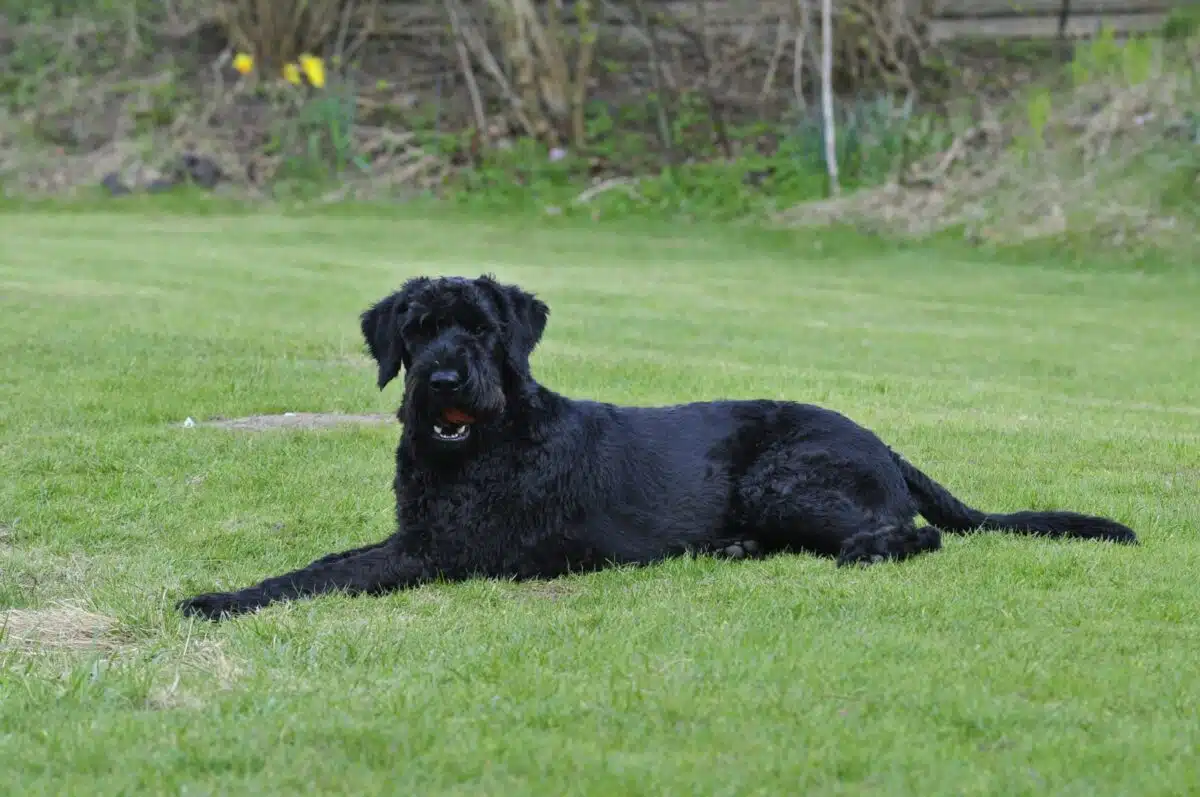Welcome to this Giant Schnauzer-guide.
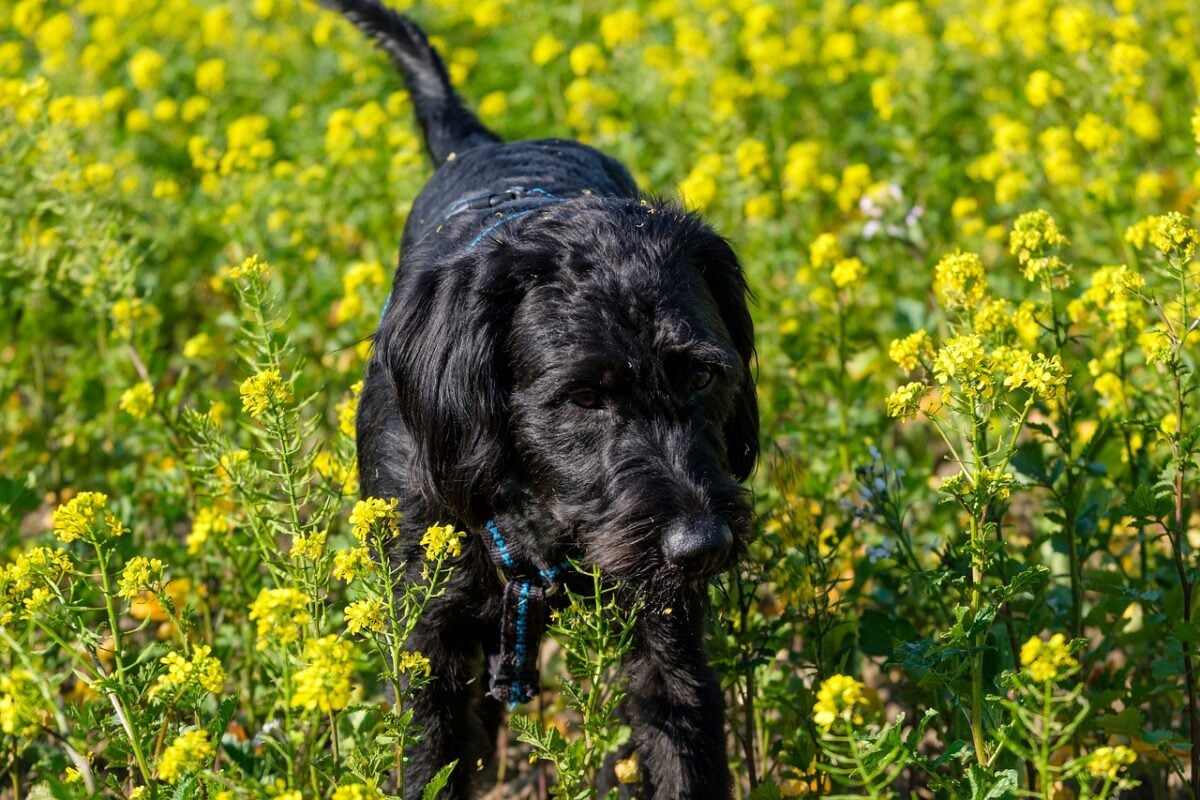
We are sure that you’ve heard about miniature schnauzers but are probably in deep love with them due to their cute little size and cuddly appearance.
However, those cute little things are not focus of today. Instead, we will be focusing on the Giant Schnauzers, which are not as little or obedient as miniature schnauzers. Nonetheless, we guarantee you won’t resist falling for them.
Let’s take a closer look:
An Overview of the Giant Schnauzer
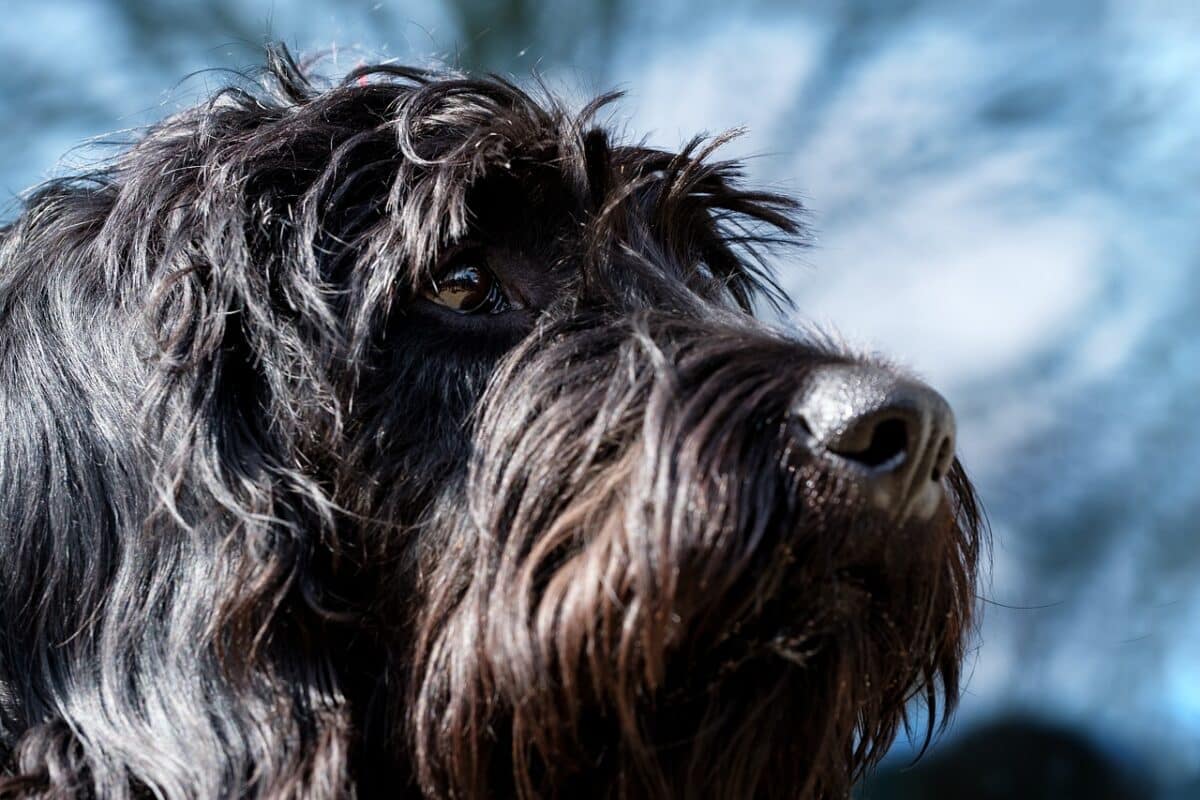
As the name indicates, Giant Schnauzers are the largest breed of Schnauzers. They are known to have rugged and big-sized bodies with commanding appearances and confident expressions. However, their dominating behavior and powerful appearance are somewhat misinterpreted. There is also a twinkle in their eyes, hinting at their mischievous temperament.
Here is a complete overview of the Giant Schnauzer:
| Common Name | Giant Schnauzer |
| Scientific Name | Canis lupus |
| Breed Type | Working Dogs or Watchdogs |
| Origin | Europe |
| Slogan | Large, powerful, and dominant |
| Temperament | Dominant and Usually Quiet |
| Height | Approximately 25 inches |
| Weight | Approximately 77 pounds |
| Life Expectancy | 12 years |
| Barking | Silent |
| Anxiety | Low |
| Preferred Temperature | Warm climate |
| Exercise Needs | Need a loot of exercise |
| Shedding | Low |
| Grooming | Weekly |
Giant Schnauzer’s Origin and History
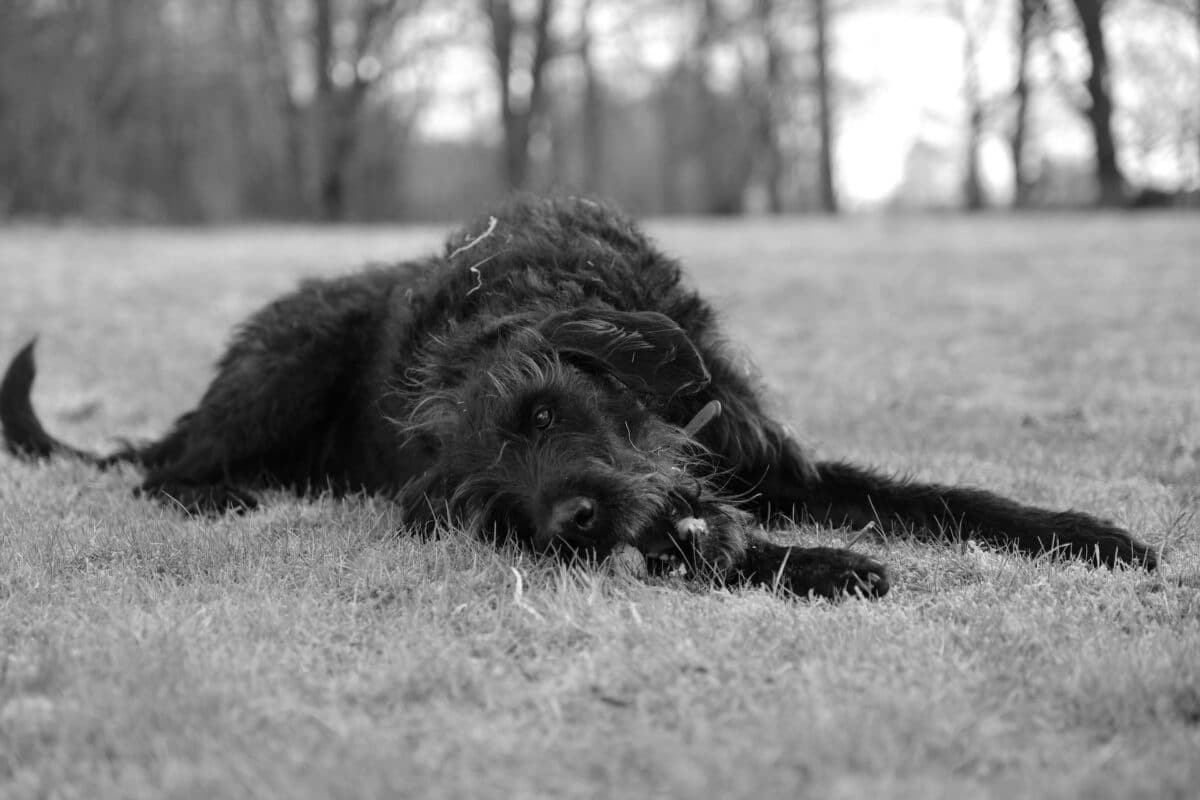
The Giant Schnauzer is a specific breed of large and working dog whose origin dates back to the 17th century.
More precisely, the first breed of giant Schnauzers was conceived by crossing the Standard Schnauzer with larger species, including the Great Dane, Rottweiler, and Bouvier des Flandres in Germany.
The main objective of their breeding was to use them as working dogs or police dogs to herd cattle from the farm to the market safely. Another important task was to protect these animals from big-sized wolves.
In addition, they were also used as military dogs to accompany arm forces in specific missions. Peculiarly, the breed has worked as military dogs with European arm forces. That is why the breed is typically known for possessing power, dominance, intelligence, and loyalty.
As you can see, all these traits make them appropriate for their roles.
Giant Schnauzer’s Scientific Classification
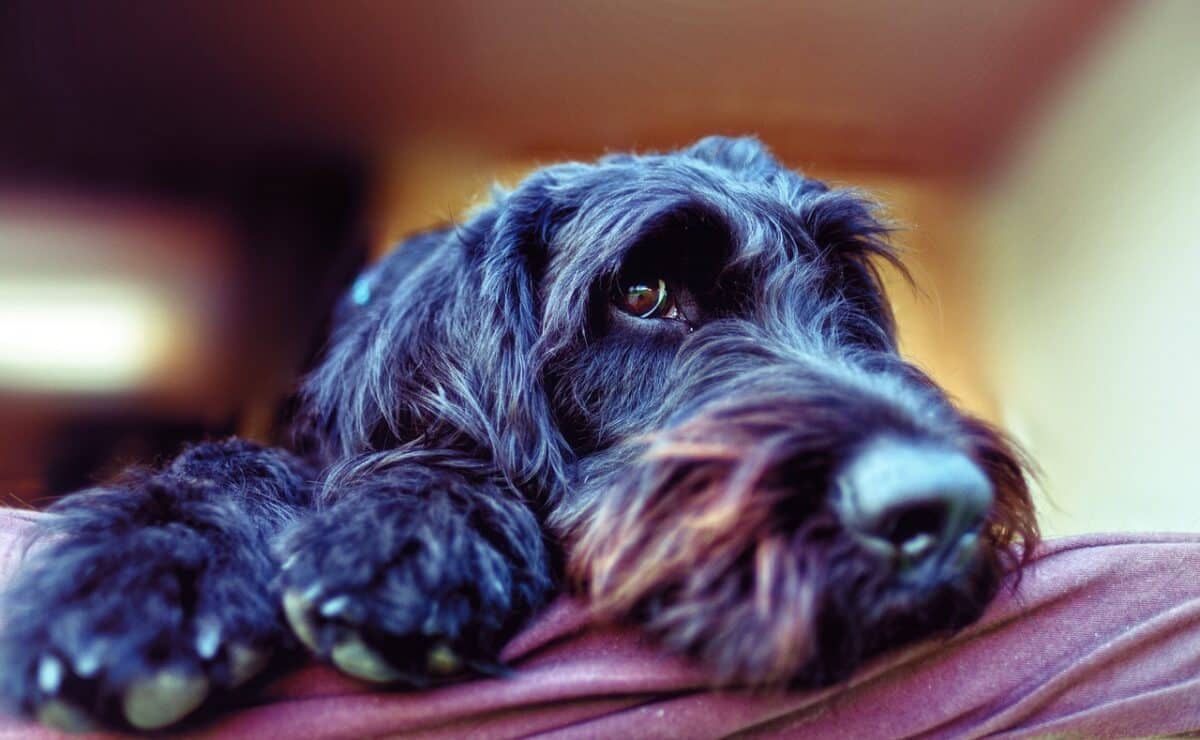
Giant Schnauzer is a particular breed of dog scientifically known as Canis lupus and belongs to the family Canidae. Giant Schnauzer’s phylum is Chordata of the class Mammalia from the order Carnivora. The breed belongs to the Canis genus.
Notably, this particular dog breed is known for its huge size and dominant nature.
Giant Schnauzer’s Appearance
As its name suggests, Giant Schnauzers are a breed of giant-sized and powerful dogs. Their height typically ranges between 27.5 to 32.5 inches, and their weight is between 55 to 85 pounds. They are usually only seen in just one color, which is black.
Another distinctive feature of the Giant Schnauzer is its wiry, all-black, or rarely salt-and-pepper coat. It is thick and requires, if not daily, then weekly grooming for fur maintenance.
More precisely, Giant Schnauzer has a double skin that is also water-resistant. Despite their dense and wiry coats and heavy beard, the breed does not shed very much. They are often assumed to be hypoallergenic breeds.
Furthermore, since these are watchdogs, their bodies are sturdy and robust with a docked tail. Their head is strong, and their face is covered with heavy beard and mustache.
Notably, their ears are generally cropped to stand erect. Everyone can guess that Giant Schnauzers are watchdogs, as their expressions are usually confident and alert. In a nutshell, Giant Schnauzers are a powerful and dominant breed of dogs whose appearance perfectly aligns with their duties.
Here is a more precise overview of Giant Schnauzers’ size.
Weight (Male) 60 pounds to 85 pounds
Weight (Female) 55 pounds to 75 pounds
Height (Male) 25.5 inches to 27.5 inches
Height (Female) 23.5 inches to 25.5 inches
Giant Schnauzer’s Behavior and Temperament
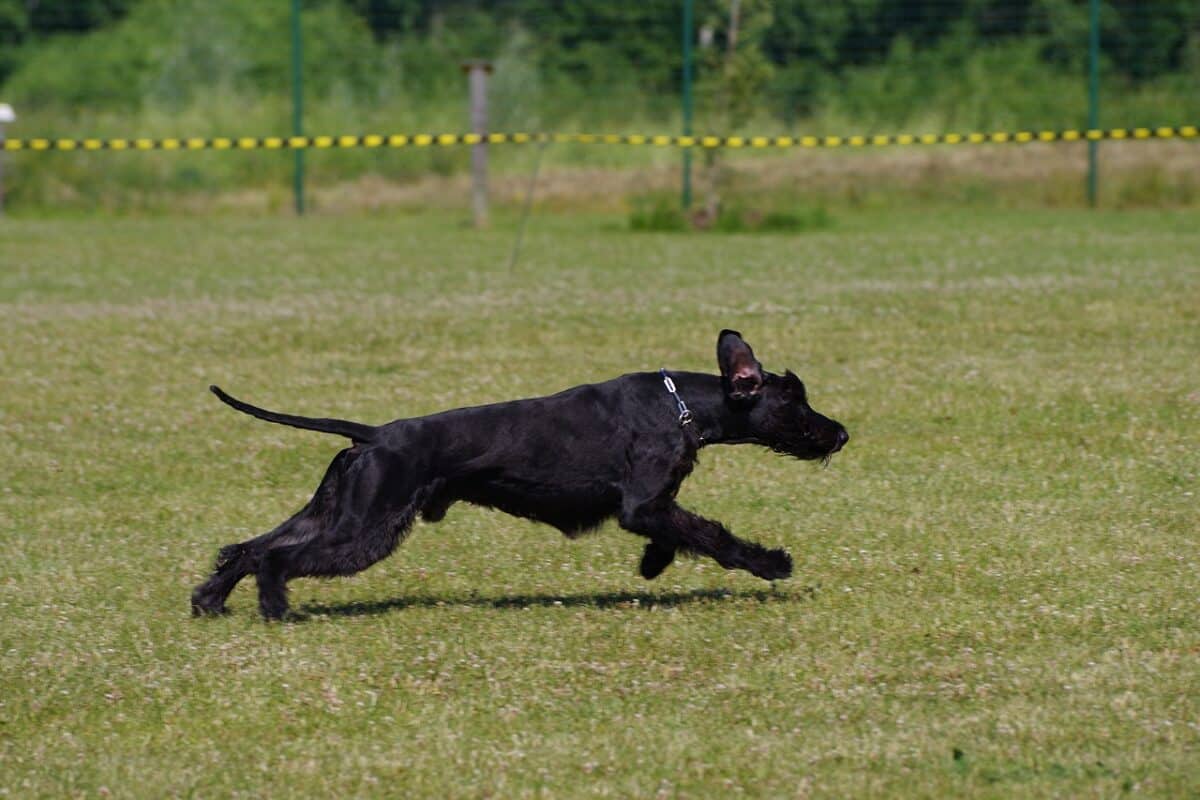
As mentioned earlier, the Giant Schnauzer is a strong-willed, powerful, and confident breed. Their ability to sense danger is as good as their loyalty. In addition, the species is known for its intelligence and positive response toward trainability.
However, the breed is also known for its stubborn nature, which may cause training a bit challenging, but if you tackle it strategically and train them consistently, you will achieve your desired results. The breed is mainly known for its defensive skills, as they have been used as watchdogs by farmers and shepherds to protect their livestock.
Overall, the Giant Schnauzers are quiet. The best thing about these dogs is that they do not bark unnecessarily. They only bark when they sense any danger for themselves or their family. Due to their protective nature, they may be a little wary of strangers.
Moreover, it has been observed that they have high energy levels and require regular exercise and mental stimulation to deplete their energy. Otherwise, these energy levels often result in destructive behavior or an aggressive demeanor.
Lastly, the Giant Schnauzers’ loyalty needs to be underlined and applauded. Their loyalty is beyond any parameter, making them the ideal watchdogs. Due to their quietness, loyalty, and minimal shedding, Giant Schnauzers can become good family dogs. However, it would be best to be a little cautious about toddlers or kids while surrounded by Giant Schnauzers.
Giant Schnauzer’s Common Health Issues
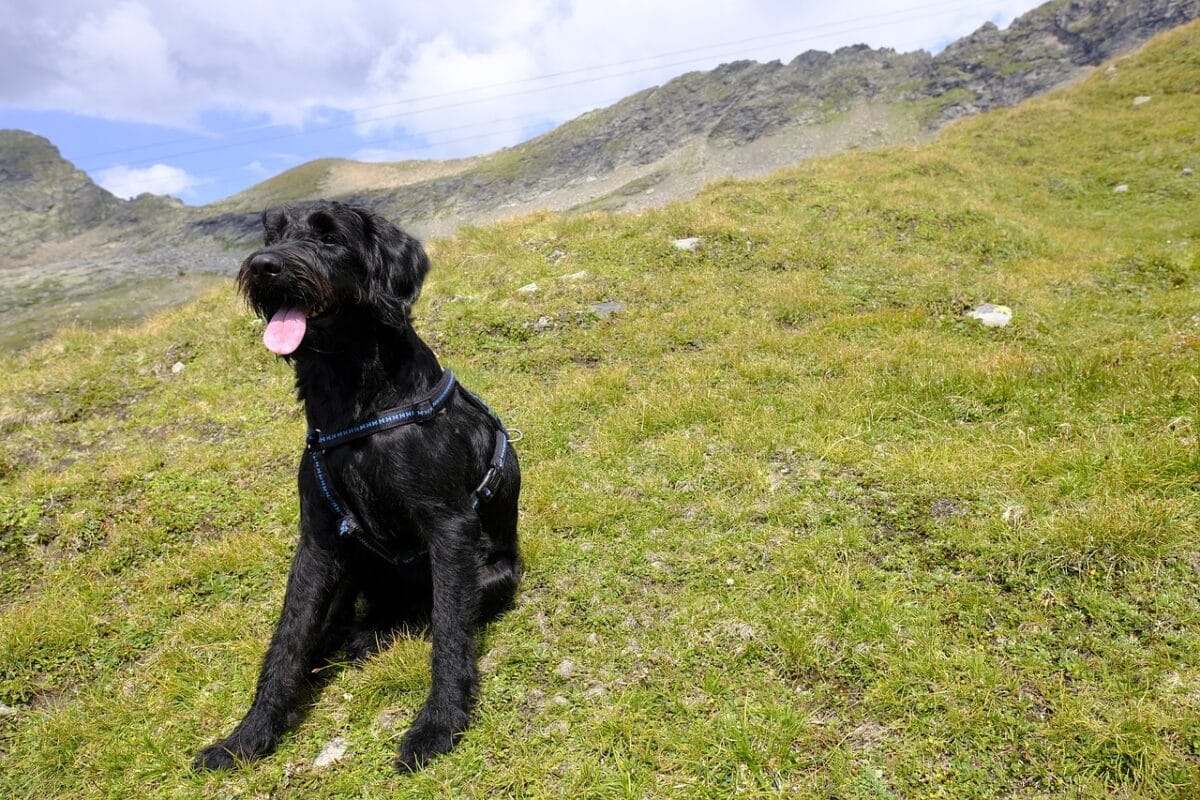
Like any other dog breed, Giant Schnauzers are likely to develop specific health concerns. Some of the most common health issues are outlined below.
#1 Dental Disease
A common health concern among Giant Schnauzers is dental health, which may deteriorate due to irregular brushing, oral un-hygiene, or tartar buildup.
#2 Bacterial and Viral Infections
Giant Schnauzers are also prone to suffer from viral or bacterial infections, including rabies, parvo, distemper, etc., to avoid such conditions. It is obligatory to get your dog vaccinated by an authorized vet.
#3 Hip Dysplasia
Hip dysplasia is another considerably common health concern. It is a genetic condition that affects the hip joint and can cause pain and arthritis. Luckily it can be treated through proper medication and regular exercise.
#4 Bloat (Gastric Torsion)
Another common health issue among giant Schnauzers is bloating. It is also known as gastric dilatation and Torsion, in which the stomach fills with gas and twists on its axis, cutting off blood flow and causing the stomach to swell.
Notably, the problem is more common in deep-chested breeds of dogs. The symptoms of bloating include a distended abdomen, restlessness, excessive salivation, and vomiting.
#5 Obesity
Another potential health issue that may occur to Giant Schnauzers is obesity. As already discussed, they are large animals that need proper diet and nutrition. However, sometimes, they are fed more than the required amount of food they need, which leads to obesity.
Also, it must be highlighted that obesity may lead to several other health concerns, such as digestive disorders, heart disease, and back pain. To mitigate the risk of developing obesity, do not feed your dog more than the required amount, and make sure they exercise regularly.
Giant Schnauzer’s Maintenance and Grooming
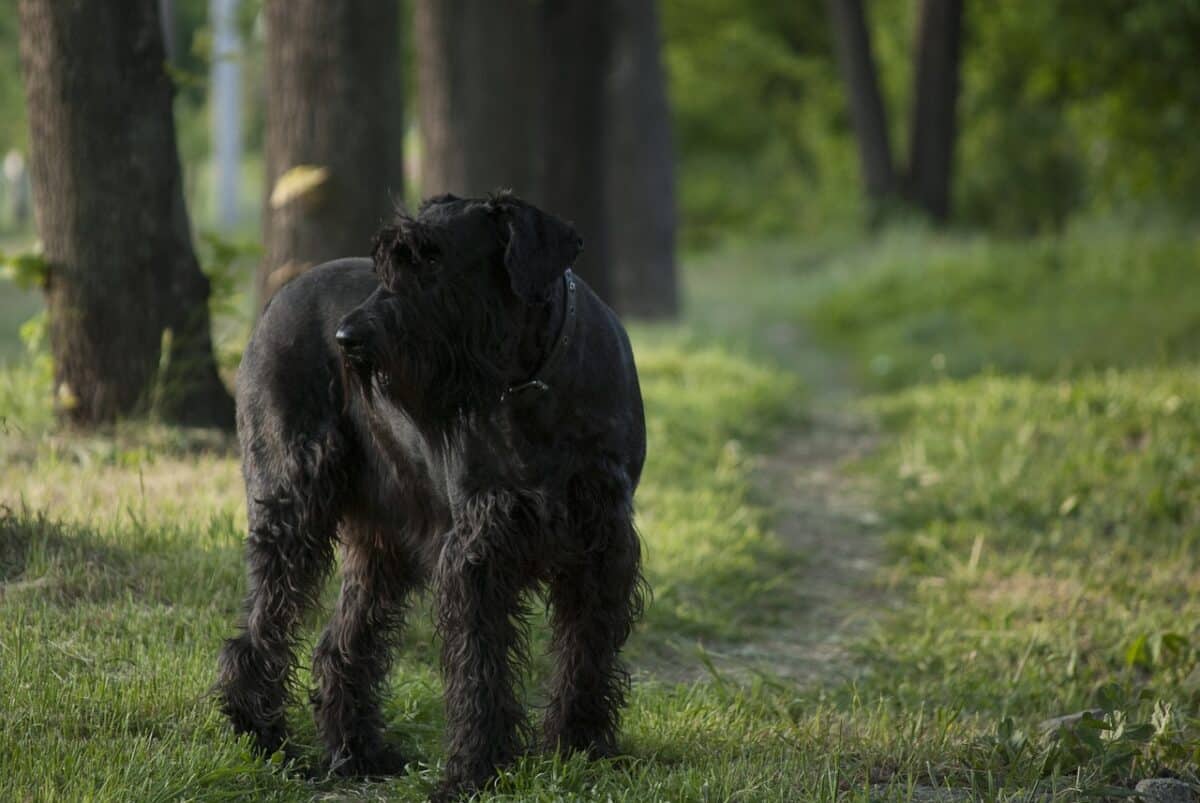
As discussed above, Giant Schnauzers typically have dense and wiry coats, which makes their maintenance more time-consuming. Therefore, weekly brushing and grooming are crucial to maintaining their thick coat.
If you are keeping a Giant Schnauzer for the first time, you are advised to take the help of a professional person for their grooming. Or you can also learn how to groom Giant Schnauzers properly at home through youtube videos or by googling.
In addition to their regular brushing, you also need to check their ears regularly. Clear the way and be cautious of any signs of infection. Moreover, it would be best to trim their nails weekly to prevent your dog from getting hurt while walking.
Lastly, brushing their teeth on a weekly basis should be on your priority list as they are prone to develop dental issues.
Giant Schnauzer’s Training
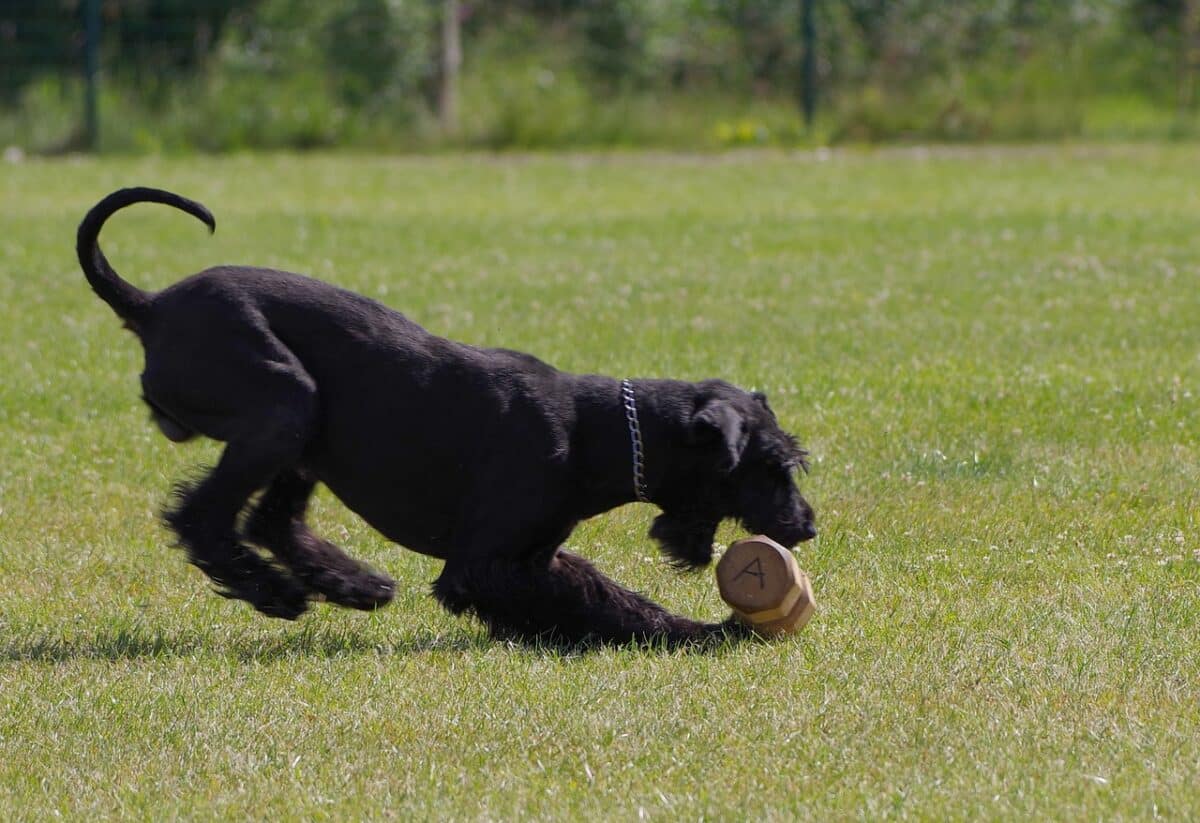
The Giant Schnauzer is an intelligent breed capable of getting trained easily. Remember that they are known to have a stubborn nature, which means their training needs to be done strategically, along with giving them positive reinforcements.
Here are some tips for training a Giant Schnauzer more conveniently:
- Start early: The earlier you begin training your Giant Schnauzer, the better results you will get. Puppies are comparatively easier to train. Classes at an early age are a great way to teach basic obedience commands.
- Use positive reinforcement: Positive reinforcement training methods are the most effective for Giant Schnauzers.
- Provide mental stimulation: The Giant Schnauzer is intelligent and requires regular mental stimulation to keep them engaged and challenged. Try incorporating puzzle toys, training games, and advanced obedience exercises into your training routine.
- Provide physical exercise: The Giant Schnauzer is an active breed and requires regular exercise to keep them physically and mentally healthy.
- Be consistent: Consistency is critical when it comes to training a Giant Schnauzer. Stick to a regular training schedule and use the same commands and methods every time.
- Let Them Socialize: Socialization plays a vital role in the Giant Schnauzer’s training. Since they are more likely to be wary of strangers, thus, socializing can help them to become more comfortable and easy-going around new people and other dogs.
With patience, consistency, and positive reinforcement, the Giant Schnauzer can become a well-trained and well-behaved family dog.
Dogs Similar to Giant Schnauzers
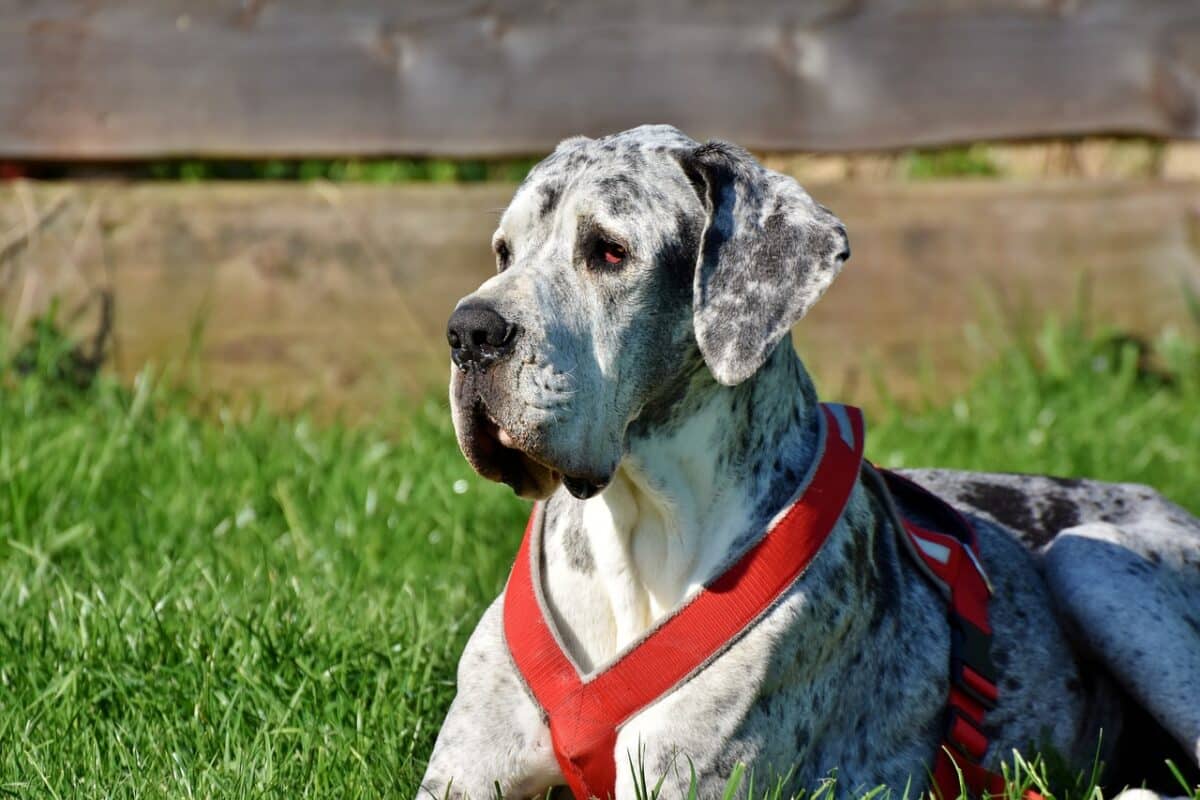
Generally, three dog species are pretty identical to the Giant Schnauzer. Here is a brief overview of these three species and their similar traits.
- Black Russian Terrier: Black Russian Terriers, aka Tchiorny Terriers, are also large, powerful, and dominant breeds initially bred for working purposes. Their size, power, and abilities are shared traits. However, Giant Schnauzers are considered more intelligent than Black Russian Terriers.
- Great Dane: Similar to Black Russian Terriers and Giant Schnauzers, the Great Danes are large working dogs with high intelligence. However, Great Danes are more playful and a better family pet for families with younger kids than Giant Schnauzers.
- Airedale Terrier: Airedale Terriers and Giant Schnauzers are known and considered identical due to their thick and wiry coats. Despite having dense coats, neither breed shed excessively.
Pros & Cons of Keeping Giant Schnauzer As A Pet
As mentioned earlier, the breed originated as working dogs, meaning loyalty and protection are the two primary traits you will witness in a Giant Schnauzer as a pet.
What else can you expect from them as your furry friend? Do they make good pets? Here are a few pros and cons of owning a Giant Schnauzer as a pet:
| Pros | Cons |
| Loyal: The loyalty of Giant Schnauzers is a thing to talk about. You may doubt your life partner for a moment, but you won’t question this breed’s loyalty once you indulge with them. | They can be aggressive: Their dominant nature instantly comes into action when they sense any threat to themselves or their owners. |
| Hypoallergenic: Giant Schnauzers are more likely to be hypoallergenic, which means that they do not shed and can be a safe pet for people prone to allergies. | Nonfriendly to young children: if you have young kids at home, youmight want to re-consider getting a Giant Schnauzer due to its super-dominant nature. |
| Easy to train: Giant Schnauzers are police or watchdogs known for their impressive skills and intelligence. | They can become destructive: they need proper exercise daily, and if they do not do enough physical activities, it may result in their destructive nature. |
FAQs
– To keep their temperament under your control, train them consistently and politely. Give them positive rewards and reinforcements to learn faster.
– Brush their dense coats if not daily, then for sure weekly.
– Give them a proper diet that fulfills their dietary and nutrition needs.
– Take them out for exercise as their energy levels are higher, and you need to give them stimuli to use their energy.
– Be cautious about their health issues. Get them vaccinated and take them to an authorized vet for quarterly checkups.
– Avoid leaving them alone with your younger children.
– Hand-stripping the coat
– Brushing the coat
– Bathing your Schnauzer
– Cleaning their ears
– Trimming their nails
– Brushing their teeth
Yes, without any doubt. It is because of their loyalty, intelligence, low barking tendencies, and minimal shedding. In addition, since these dogs were bred to protect the livestock of shepherds, therefore they possess dominant nature, although this sometimes results in an aggressive nature. But the good news is that they are trainable.
The Final Word
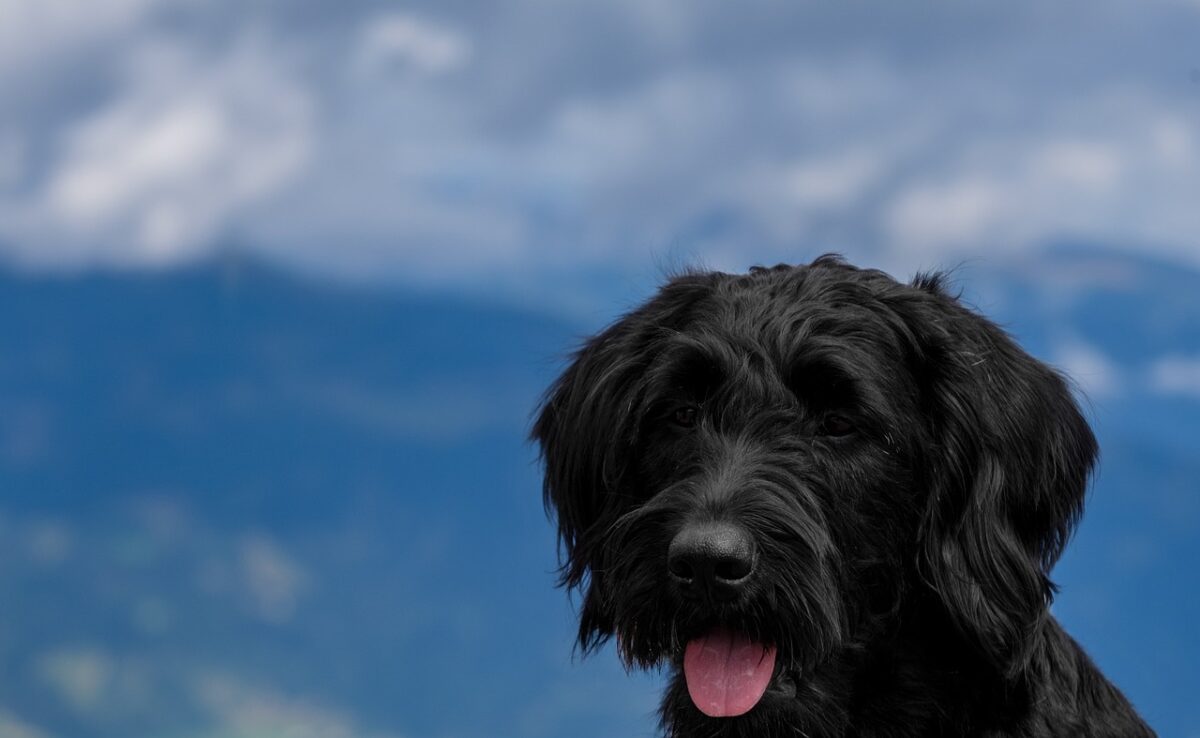
To conclude, the Giant Schnauzer is a breed of big-sized dogs that originated in Germany in the 1600s. They were typically bred to work as work companions of shepherds or watchdogs of cattle. This was due to their robust body, large size, and outstanding protective nature.
Additionally, the breed is famous for its outstanding capabilities, intelligence, and loyal nature. Lastly, Giant Schnauzers make good family pets and amazing companions but need consistent training and socialization from an early age.
Thank you for reading this article! If this doggo doesn’t seem to be suited to you, or you simply just want to expand your knowledge on dog breeds, continue reading about the Toy Poodle or Sheepadoodle.
- Chicago Cat Jumps From 5th Floor of Burning Building and Survives - April 22, 2024
- The Cruelest Contest in the World: Rattlesnake Round-Ups - April 21, 2024
- Rare Footage: Wild Fox and Pet Cat Play-Date - April 21, 2024

